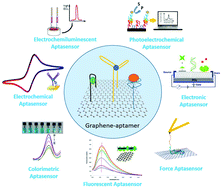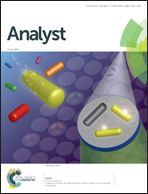Graphene-based aptasensors: from molecule–interface interactions to sensor design and biomedical diagnostics
Abstract
Graphene-based nanomaterials have been widely utilized to fabricate various biosensors for environmental monitoring, food safety, and biomedical diagnostics. The combination of aptamers with graphene for creating biofunctional nanocomposites improved the sensitivity and selectivity of fabricated biosensors due to the unique molecular recognition and biocompatibility of aptamers. In this review, we highlight recent advances in the design, fabrication, and biomedical sensing application of graphene-based aptasensors within the last five years (2013–current). The typical studies on the biomedical fluorescence, colorimetric, electrochemical, electrochemiluminescence, photoelectrochemical, electronic, and force-based sensing of DNA, proteins, enzymes, small molecules, ions, and others are demonstrated and discussed in detail. More attention is paid to a few key points such as the conjugation of aptamers with graphene materials, the fabrication strategies of sensor architectures, and the importance of aptamers on improving the sensing performances. It is expected that this work will provide preliminary and useful guidance for readers to understand the fabrication of graphene-based biosensors and the corresponding sensing mechanisms in one way, and in another way will be helpful to develop novel high performance aptasensors for biological analysis and detection.

- This article is part of the themed collections: Recent Review Articles, In celebration of Chinese New Year 2020 and Bioanalytical Sensors


 Please wait while we load your content...
Please wait while we load your content...